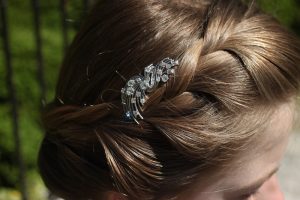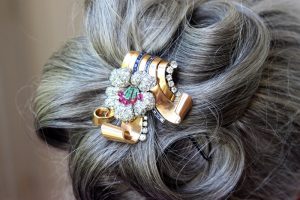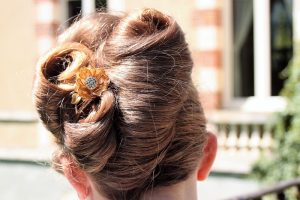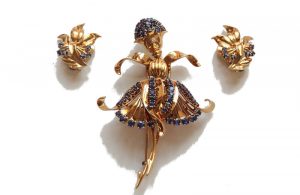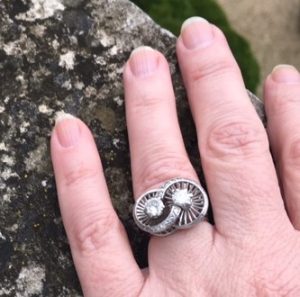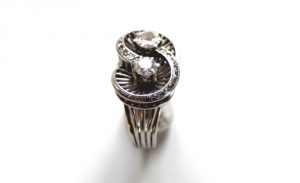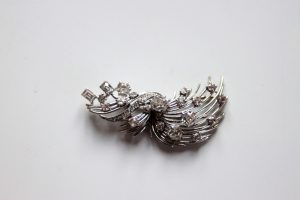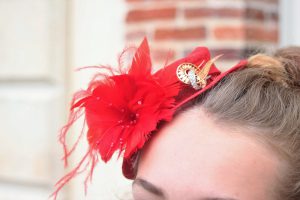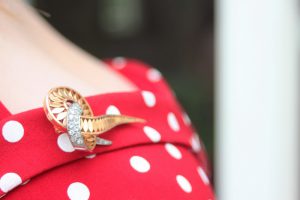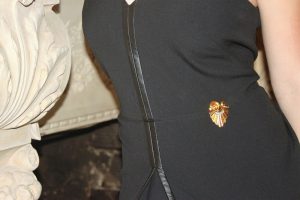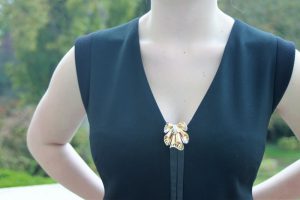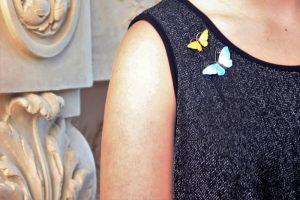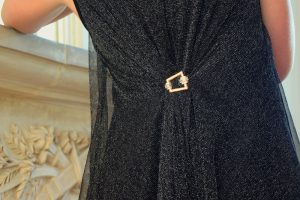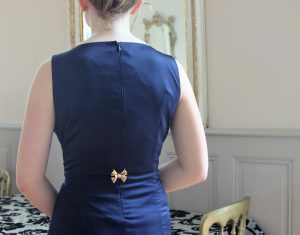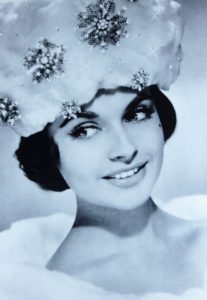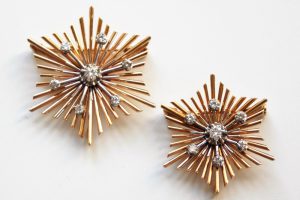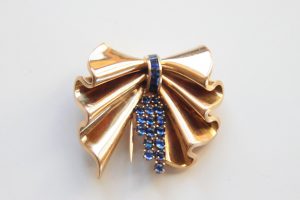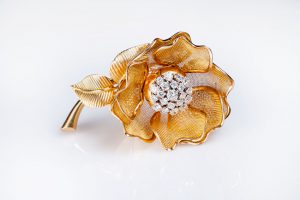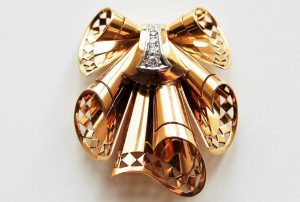Brooches are on a comeback tour. Especially vintage and retro brooches from the 1930s to the 1960s made in gold, platinum, diamonds and colored stones. They are often beautifully hand crafted, precious and very stylish. But instead of the obvious lapel or corner of a jacket, why not pin them on an unusual place? Brooches are far more versatile than you think. You can pin them in your hair. Use brooches as hair ornaments and fixate them with simple hairpins. You can stick them in a braid, a knot or a chignon. All ages can wear brooches in their hair, for a sweet 16 party, a prom, a wedding, a promotion or a gala. It’s chic, you will stand out from the crowd and you give a brooch a new life.
Category Archives: What’s new & Jewelry storytelling
John Rubel ballerina
“John Rubel’s jewels have always danced. My wish today is that they resume their ballet of shapes and colors“, says Sophie Mizrahi-Rubel, granddaughter and president of John Rubel Paris.
The Franco-American company which was founded by the two Hungarian Rubel brothers had from 1943 to 1947 a New York branch. It was in a famous nightclub that John Rubel scribbled the design for the ballerina brooch on a napkin. He gave the serviette to Maurice Duvallet to work out the design. Duvallet worked also for Van Cleef & Arpels and VCA took one of the ballerina’s in production. It was Van Cleef & Arpels who made the ballerina brooches famous, but the father of the ballerina was unmistakably John Rubel. The brooch is part of a demi-parure with a pair of earrings set in 18K gold and sapphires.
Toi & Moi ring
Who can say my wife (girlfriend) or my husband (boyfriend) is my best friend is very rich and blessed in life. A French Toi & Moi ring represents this idea: 2 stones or 2 pearls representing 2 souls intertwined until death do us part. Although these types of rings were already made in the beginning of the 18th century (see also Le bijou de sentiment, an exhibition organised by Chaumet in 2008), I believe it was Napoleon who made this type of ring popular. The to be French emperor offered his future empress Josephine a toi et moi engagement ring in 1795. The ring was made of a diamond and sapphire pear and was sold in 2013 at auction for a million euros. Although not worn by an empress I offer a beautiful and moderate priced toi & moi ring from the 1950s. The 2 diamonds are set in a platinum eternity sign. This ring might just be the perfect gift for your Valentine.
Bewaren
How to wear vintage jewelry: brooches, pins and clips (part V)
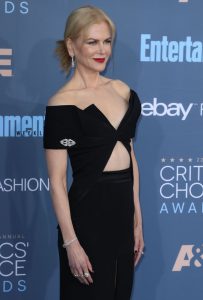
Nicole Kidman at the Critic’s Choice Awards in Santa Monica december 2016, wearing a vintage brooch on the sleeve of her dress
I found a photo of Nicole Kidman attending the Critic’s Choice Awards in Santa Monica last year. Do you see where she is wearing her vintage brooch? Pretty fancy place! The geometric pattern of the brooch compliments the triangle forms of her dress. I have in my shop a Mauboussin diamond spray clip from the 1950s. I’m looking for the dress that goes well with this form. Maybe an asymmetric dress from the retro period. Anyone?
How to wear vintage jewelry: brooches, pins and clips (part IV)
Here is a selection of some alternative ways to wear a brooch on cocktail dresses and frog gowns. You can accentuate your body parts, you can hide a zipper or tighten a dress or just stand out from the crowd.
- how to wear vintage jewelry
- how to wear vintage jewelry
- how to wear vintage jewelry
- how to wear vintage jewelry
- how to wear vintage jewelry
- how to wear vintage jewelry
- how to wear vintage jewelry
- how to wear vintage jewelry
- how to wear vintage jewelry
- how to wear vintage jewelry
Set of 1940s snowflake brooches

Nice example of how to wear a set of vintage brooches, one little bigger than the other, like the snowflakes
How to wear vintage jewelry like these snowflake brooches? In the 1940s brooches were worn together as a set. In a Paris auction, I bought this lovely set of 2 small snowflake brooches. One is a little bigger than the other. Snowflakes were extremely popular after the war. Van Cleef & Arpels introduced them in 1946. Here you can see 2 advertisements of how to wear them: The lady with the snowflake brooches on her hat is from VCA and the other lady with a set of diamond clovers are from the House of Trifari.
Showers of Sapphire
I found these wonderful showers of sapphires in a Paris auction. It’s a beautiful French 18K gold retro brooch and a good example of 1940s escapism.
Escapism of the 1940s was an important motif in pre- and mid-war jewelry. Eye-catching jewelry was used to forget the doom and gloom of the war. Jewels were extravagant and extrovert, bold and bossy with voluptuous curves and plumed up into massive 3-dimensial designs. Jewelry was bursting with ribbons of yellow gold and showers of sapphires*. Indulge yourself with a beautiful pin and lift WWII escapism to modern hedonism. It is more contemporain than ever.
* quotes from “Antique and Twentieth century jewellery” by Vivienne Becker (chapter 22).
Taboo on synthetic rubies?
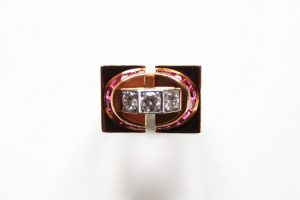
1940 TANK ring with diamonds and synthetic rubies. Sometimes my eye is caught by a very strong design, that is so appealing that I can’t go by it without touching it, louping it, putting it on and in the end buying it. And sometimes I ignore the fact that the design is set with synthetic stones. In this case this very 1940s TANK*ring. The ring is set with 3 brilliant cut diamonds that are accentuated by a row of synthetic rubies.
I think there is still a taboo on synthetic rubies and sapphires. Why is that? Costume jewelry is widely accepted and in most cases not cheap at all (think Chanel in the 1920s). Another example are glass and pastes look-a likes, they were popular for centuries. But when it comes to high end jewelry were natural stones are combined with synthetics it raises some eyebrows. Synthetics came in use after the war, although the French chemist Auguste Verneuil already invented the stones or better to say the process of flame fusion, in the 1890s. After the war natural stones were rare and synthetics were cheap and available.
Rubies were the most popular gemstones of the 1940s period. Partly because they went well with pink gold and partly because of their warm feminine colour. Smaller stones could be used to great effects. At this time synthetic stones were widely used and mixed with precious gems to create great colour effects or to accentuate, like in edges, ridges and on the side. So when you come across a piece of period jewelry with synthetic rubies or synthetic sapphires it is not to con you, but this was a logic and deliberate choice of the goldsmith or designer of that time.
*The description TANK in capitals is a referral to Machine Age Jewelry, a whole different chapter. More on TANK jewelry coming soon.
The story behind the rose on my page
I came across this delicate rose at a local French auction and fell in love with it. It resembles an Eglantine rose, like the ones I have in my garden (for the garden lovers: Rosa rugosa “Blanc double de Coubert”). The petals are made of gold mesh, a technique which was introduced in 1946. The French call this style “ à tamis” or ”sieve”. The diamond hart you can scroll off and can be replaced by a gemstone hart in a different colour, but unfortunately this pin is missing the blue or pink hart. The rose can be worn as a pin but also as a pendant. The petals can move slightly back and forwards so that the rose closes itself for the night.
Besides the hallmarks for 18K gold, the back of the rose is stamped: “BTE SGDG”, this mention was in use between 1844 and 1968. “Bte” is short for “breveté” (=“patented”) and ” S.G.D.G.” stands for “Sans Garantie Du Gouvernement” =”without government guarantee” and means that the government was not liable for the working of the product.
Frozen movements in gold

Retro design of the 1940s, the undulating lines are typical of that time and refer to new inventions in fabric like rayon.
New in my shop are thes very strong and stylish Retro designs. Characteristic of the 1940s were the stiff and fluid lines like frozen movements and the use of “fabrics”. The handkerchief motif and the undulating lines in both brooches referred to the new artificial fabrics such as jersey or rayon, which were particular soft and fluid. Wear these pins high on the shoulder, as high as the collar bone, that was ‘en vogue’ in those years.
Bewaren
